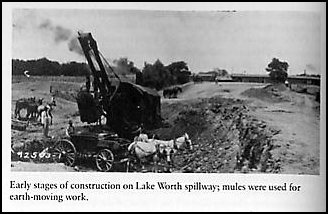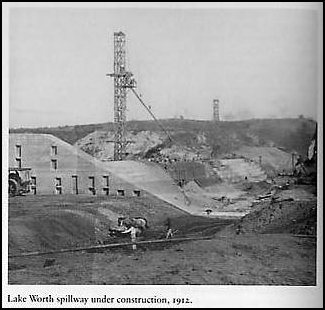
Tarrant County, TXGenWeb
The Building of
Lake Worth
(Published Jan. 16, 2003, NW
Times-Record)
Contributed by
Kenneth Klein
Staff Writer, NW Times-Record
A Lake for Fort Worth
Around the turn of the century, as Fort Worth began the transition from a ‘six-shooter’ town to an industrialized city, the need for an additional water source - a renewable one - became paramount. Lake Como, the first man-made lake in Fort Worth, was small and isolated from the Trinity and inadequate as a water source. Fort Worth still had to rely on its own water wells for drinking water and sanitation purposes. In 1903, the thirteen artesian wells at the Holly Plant had stopped flowing, and the Clear Fork supply of untreated water was unacceptable. It was a common practice to throw trash into the river, Additionally, runoff from stables and outhouses had contaminated the water, and epidemics of typhoid fever and smallpox ravaged the city. Flood control for the Trinity River was also a consideration.
This was an old problem for Fort Worth, beginning in 1882 when Mayor John Peter Smith rallied the fight for a new system that would provide an adequate water supply for a city he predicted one day may reach 100,000 people. His first order of business was eliminating the practice of dumping trash into the river. His next goal was to try to drill more artesian wells. Daniel Mead, a Chicago engineer, drilled a large shaft near the Holly Plant, then bored tunnels to each of the thirteen wells, but that did little good. J.J. 'Doc' Peters, who just happened to be a well driller, announced that huge supplies of artesian water lay under Fort Worth. He proved it by drilling a well at Florence and Sixth and striking pure, soft water. So digging wells became a pastime in the city. More than 200 wells were drilled in the next few months, and the optimists predicted artesian water was now on hand for all foreseeable needs. They were wrong, of course, and by 1882, in Mayor Smiths' administration, the city was spending thousands of dollars in a fruitless search for more water.
In 1894, an investigation from Engineer John Hawley (father of Freese and Nichols) recommended that a surface water reservoir was the "logical ultimatum" to the City's water problem. but his request met with consternation from the Council - mainly the scope of the project and the cost. The Council remembered all too well what happened to the last City Council that spent "too much money" for the new Tarrant County Courthouse. They were never re-elected!
But the public demanded action! But it wouldn't be until 1910, under the Davis administration that action would be taken. Civic leaders recalled Hawley's investigation, and the Fort Worth Chamber of Commerce (known then as the Board of Trade) appointed him to a board of engineers to study the question and determine the best surface water source. Also appointed to the board and serving as it's chairman was J.D. Trammell, Fort Worth City Engineer. They in turn appointed T. Taylor, Dean of the Department of Civil Engineering at the University of Texas. They released their report early in 1911 that a dam be built on the West Fork of the Trinity to provide an abundant water source. So construction plans for the spillway were made. The idea of an artificial lake of such proportions was amazing at the time, and when complete would be the largest manmade lake in Texas. It has since been the model in construction of every similar project made, including Eagle Mountain and Benbrook Lakes.

The construction of Lake Worth began in November of 1911. The lake was originally called "Lake Minnetonka" but changed to Lake Worth a year later in 1915. It involved deepening and widening the Trinity River, including the building of a dam. The creation of this lake was primarily done by hand or mule power. A few primitive steam shovels and tractors did what the mules could not. Excavating was performed by pulling a Frisno behind a team of horses or mules. The Frisno was a cross between a plow and a wheelbarrel, and was laborious to operate. The trick was to make the livestock do all the work - so the operator would just have to force the Frisno into the ground. The livestock would pull it forward, forcing the earth into the hopper. Once the hopper was filled, it could be dumped out on the side, or at the front. Another logistical problem was where to dump the earth? No one wants to duplicate their efforts. The work was coordinated with a team of Frisno drivers. The mules also served as dump trucks, hauling wagons of excavated earth to build the earthen dam. Construction of the spillway was started in 1912 and completed in 1914 at a cost of 1.6 million. The dam is about 3,220 feet long and the concrete spillway 700 feet wide. The spillway was capable of carrying 10 feet of water overflow. The earthen part of the dam was built up of clay and sandy loam laid down in one foot horizontal layers, well wetted and rolled. During the excavation for the masonry spillway in 1912, an interesting question arose. The board of engineers' principal assistant asked for instructions as to the classification of shale in the excavation. The engineers told him that six good mules should be the gauge of difference between earth and loose rock: "If six good mules could not plow the material, it should be classed as earth; if not, it should be classed as loose rock".

But while the project was nearing completion, only Trammel would remain on the board for the duration. Taylor resigned in December 1912, followed by Hawley in January 1914. Political interference and friction between board members were cited as reasons for the resignations.
Accessibility across the lake was by the Nine-Mile-Bridge, it being nine miles from downtown Fort Worth - hence the name. It was a narrow concrete bridge with wooden planks on top for foot and horse traffic. The gateway to the bridge was on the east side by Rench Road, via Azle Avenue, the only road to Fort Worth at the time. Jacksboro Highway was little more than a dirt road.....................
When the work was completed, the lake was approximately 20 miles in length with a maximum width of two miles, and its’s sounding depth was sixty feet. It was estimated that it would take about 3 years to fill the lake’s estimated 13 billion gallon capacity. But in 1914, heavy rains shortly after construction reduced that to 3 weeks! So there came to be Lake Worth - Fort Worth’s lake. At the time, this lake, with 5,299.20 acres of surface water, was the largest manmade lake in America. It was decided early on to make Lake Worth a scenic attraction, easily accessible, and a center for recreation. Surrounding the main body of water were numerous bays, inlets and open vistas with a meandering outline fringed by trees.
Bibliography:
A Century in the Works: Freese and Nichols Consulting Engineers, 1894-1994, Simon W. Freese, P.E. and Deborah Lightfoot Sizemore
Fort Worth: Outpost on the Trinity, pgs 177-178, Oliver Knight
This page was last modified 13 Feb 2003.
Copyright © Tarrant County, TXGenWeb 2003. All rights reserved